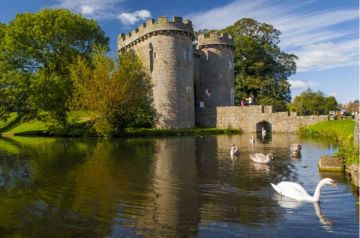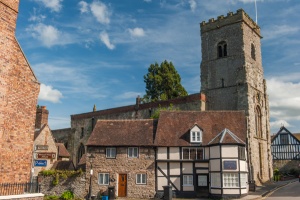
The medieval church of Holy Trinity stands beside a long church green, near timber-framed cottages and the medieval guildhall of Much Wenlock. The origins of Holy Trinity go back to the 7th century, when Milburga, daughter of Merewalh, King of Mercia, founded a religious community here.
Milburga's foundation was a double house, with separate quarters for monks and nuns. Her monastery eventually grew to become Wenlock Priory, located a short distance away down Sheinton Street.
We do not know exactly where the abbey church stood; it may have been near the later medieval Priory church, or perhaps on the site now occupied by Holy Trinity. An alternative theory is that the monk's church was where the priory church stands, and Milburga's original nun's church was on the site of the current parish church.
In any case, nothing earlier than the 12th century now stands above ground in the current church building.
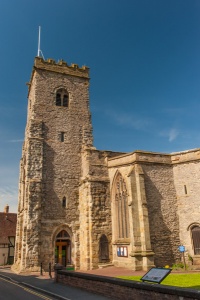
The church we see today was erected by the Cluniac monks of Wenlock Priory, beginning around 1150, and the nave and chancel show typical rounded Norman arches and pillars. The beautifully carved 12th-century west front is now partly obscured by the later west tower, but you can still see the Norman carvings of the west tower arch.
One of the more interesting monuments within the church is relatively recent; against a portion of the west wall is a marble memorial to the Victorian doctor, William Penny Brookes (1809-1895), known as the founder of the modern Olympic Games.
Brookes established the Wenlock Olympian Games in 1861. The Games are still held each year and provided the inspiration for Pierre de Coubertin and the Olympic movement. The Brookes family graves are in the churchyard and are decorated with Olympian wreaths.

memorial
Other than that there are few interesting historic memorials save a rather nice brass to Richard Ridley (d. 1592) and his wife Eleanor. This shows the couple in a traditional Elizabethan pose, facing each other across a prayer desk.
Beneath this brass is a slightly later brass tablet to Robert Thorne. Set against a wall is a very attractive memorial to Richard Corbett (d. 1771). The rather touching inscriptions tells that he is buried nearby, with the bodies of four of his children who died in infancy.
Above the south porch is a 14th-century parvise, or small chamber used as living quarters by the parish priest. over the door are a royal coat of arms to George III, dated 1801 although the frame is from 1741. One interesting oddity is painted anchor added to the coat of arms in 1831 to commemorate the coronation of the 'sailor king', William IV.
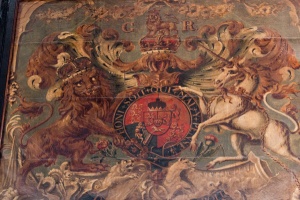
At the east end of the south aisle is a Norman font, lost for many years but rediscovered in the Victorian period and returned to the church. Set into the south wall of the sanctuary is a three-seat sedilia, which is rather impressive, though the carving appears unfinished. Near the sedilia is the large east window, with stained glass fragments from the 15th-17th century.
On either side of the sanctuary, above the altar rails, are a pair of carved stone corbel heads. They probably supported a wooden beam with a hanging fabric screen to hide the high altar during Lent. The chancel is entered through a Norman arch, with very nicely carved capitals.
The pulpit is Jacobean, and though most of the pews are Victorian you can see that earlier 18th century carved panels have been reused.
Take the time to explore Church Green, where you will find a plaque to novelist Mary Webb (1881-1927), who lived for a short time in Much Wenlock. Her most famous work was Gone to Earth, which became a popular film in 1950.
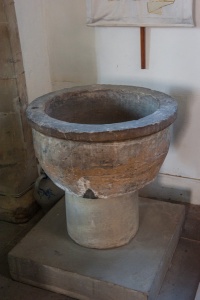
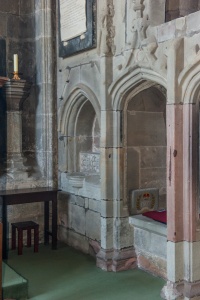
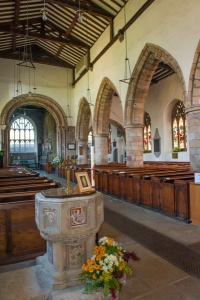
About Much Wenlock
Address: Wilmore Street,
Much Wenlock,
Shropshire,
England, TF13 6HR
Attraction Type: Historic Church
Location: In the centre of Much Wenlock near the priory and guildhall. Easy walking distance from signposted car parks. The easiest is the priory car park on Sheinton Street.
Website: Much Wenlock
Location
map
OS: SO623999
Photo Credit: David Ross and Britain Express
HERITAGE
 We've 'tagged' this attraction information to help you find related historic attractions and learn more about major time periods mentioned.
We've 'tagged' this attraction information to help you find related historic attractions and learn more about major time periods mentioned.
Find other attractions tagged with:
NEARBY HISTORIC ATTRACTIONS
Heritage Rated from 1- 5 (low to exceptional) on historic interest
Much Wenlock Guildhall - 0 miles (Historic Building) ![]()
Wenlock Priory - 0.1 miles (Abbey) ![]()
Benthall Hall - 2.7 miles (Historic House) ![]()
Buildwas Abbey - 3 miles (Abbey) ![]()
Iron Bridge - 3.9 miles (Historic Building) ![]()
Morville Hall - 4.7 miles (Historic Building) ![]()
Upton Cressett, St Michael's Church - 5.1 miles (Historic Church) ![]()
Upton Cressett Hall - 5.1 miles (Historic House) ![]()
Nearest Holiday Cottages to Much Wenlock:
Much Wenlock, Shropshire
Sleeps: 4
Stay from: £290 - 942
Much Wenlock, Shropshire
Sleeps: 4
Stay from: £508 - 1728
More self catering near Much Wenlock








